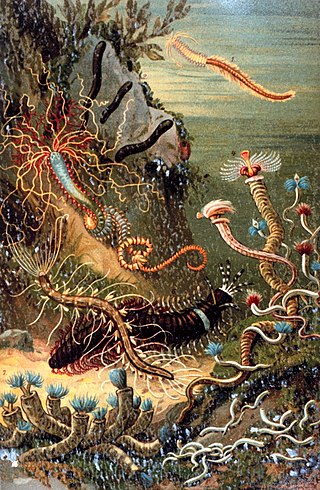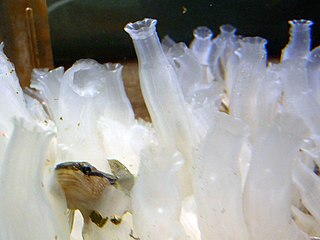
Nemertea is a phylum of animals also known as ribbon worms or proboscis worms, consisting of 1300 known species. Most ribbon worms are very slim, usually only a few millimeters wide, although a few have relatively short but wide bodies. Many have patterns of yellow, orange, red and green coloration. The foregut, stomach and intestine run a little below the midline of the body, the anus is at the tip of the tail, and the mouth is under the front. A little above the gut is the rhynchocoel, a cavity which mostly runs above the midline and ends a little short of the rear of the body. All species have a proboscis which lies in the rhynchocoel when inactive but everts to emerge just above the mouth to capture the animal's prey with venom. A highly extensible muscle in the back of the rhynchocoel pulls the proboscis in when an attack ends. A few species with stubby bodies filter feed and have suckers at the front and back ends, with which they attach to a host.

Polychaeta is a paraphyletic class of generally marine annelid worms, commonly called bristle worms or polychaetes. Each body segment has a pair of fleshy protrusions called parapodia that bear many bristles, called chaetae, which are made of chitin. More than 10,000 species are described in this class. Common representatives include the lugworm and the sandworm or clam worm Alitta.

Hector's beaked whale, is a small mesoplodont living in the Southern Hemisphere. This whale is named after Sir James Hector, a founder of the colonial museum in Wellington, New Zealand. The species has rarely been seen in the wild.

A tunicate is a marine invertebrate animal, a member of the subphylum Tunicata. It is part of the Chordata, a phylum which includes all animals with dorsal nerve cords and notochords. The subphylum was at one time called Urochordata, and the term urochordates is still sometimes used for these animals. They are the only chordates that have lost their myomeric segmentation, with the possible exception of the seriation of the gill slits. However, doliolids still display segmentation of the muscle bands.

Ascidiacea, commonly known as the ascidians or sea squirts, is a paraphyletic class in the subphylum Tunicata of sac-like marine invertebrate filter feeders. Ascidians are characterized by a tough outer "tunic" made of a polysaccharide.

Xenoturbella is a genus of very simple bilaterians up to a few centimeters long. It contains a small number of marine benthic worm-like species.

Enopla is one of the classes of the worm phylum Nemertea, characterized by the presence of a peculiar armature of spines or plates in the proboscis.

Styela clava is a solitary, subtidal ascidian tunicate. It has a variety of common names such as the stalked sea squirt, clubbed tunicate, Asian tunicate, leathery sea squirt, or rough sea squirt. As its common names suggest, S. clava is club-shaped with an elongated oval body and a long peduncle for attaching to a substrate. Although native to the northwestern waters of the Pacific Ocean, since the 1900s, S. clava has become an increasingly successful invasive species outside of its native range. It is edible.

Echinus esculentus, the European edible sea urchin or common sea urchin, is a species of marine invertebrate in the Echinidae family. It is found in coastal areas of western Europe down to a depth of 1,200 m (3,900 ft). It is considered "Near threatened" in the IUCN Red List of Threatened Species.
Opisthopatus roseus is a species of velvet worm in the Peripatopsidae family. As traditionally defined, this species is rose pink with 18 pairs of legs. Known as the pink velvet worm, it is found only in the Weza Forest, a Mistbelt Forest in South Africa.
Parapinnixa affinis, the California Bay pea crab, is a species of pinnotherid crab endemic to Southern California. It is a small crab that lives commensally in the tube of a tube-dwelling worm. It was one of the first marine crustaceans to be included on the IUCN Red List in 1996.

Acanthopagrus australis, the yellowfin bream, also known as sea bream, surf bream, silver bream or eastern black bream, is a species of marine and freshwater fish of the porgy family, Sparidae. It is a deep-bodied fish, occasionally confused with Acanthopagrus butcheri, but is generally distinguished by its yellowish ventral and anal fins. It is a popular target for recreational fishermen due to its capacity to fight well above its weight coupled with its table quality.
Gononemertes is a genus of parasitic worms.

Ciona savignyi is a marine animal sometimes known as the Pacific transparent sea squirt or solitary sea squirt. It is a species of tunicates in the family Cionidae. It is found in shallow waters around Japan and has spread to the west coast of North America where it is regarded as an invasive species.

Pyura pachydermatina is a sea tulip, a solitary species of tunicate in the suborder Stolidobranchia. It is native to shallow waters around New Zealand.
Polyandrocarpa is a genus of ascidian tunicates within the family Styelidae.
Metaperipatus is a genus of velvet worms in the family Peripatopsidae that contains two species found in Chile, including Metaperipatus inae. This genus was created by the American zoologist Austin Hobart Clark in 1913 to contain the type species, M. blainvillei. Authorities believe M. blainvillei is a species complex, however, and some consider M. blainvillei a nomen dubium.

Ciona robusta is a species of marine invertebrate in the genus Ciona of the family Cionidae. The holotype was collected on the northeastern coast of Honshu Island, Japan. Populations of Ciona intestinalis known as Ciona intestinalis type A found in the Mediterranean Sea, the Pacific Ocean, east coast of North America, and the Atlantic coasts of South Africa have been shown to be Ciona robusta.
Paul W. Sternberg is an American biologist. He does research for WormBase on C. elegans, a model organism.
Billie J. Swalla is a professor of biology at the University of Washington. She was the first female director of Friday Harbor Laboratories, where she worked from 2012 to 2019. Her lab investigates the evolution of chordates by comparative genetic and phylogenetic analysis of animal taxa.












